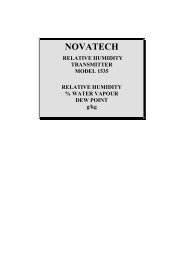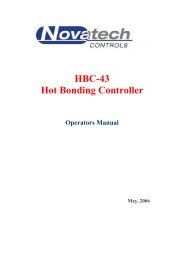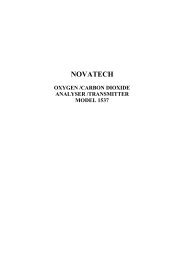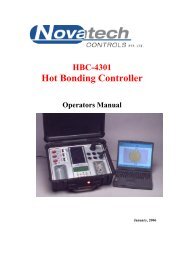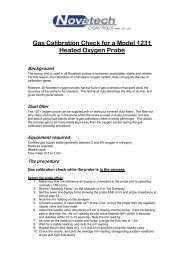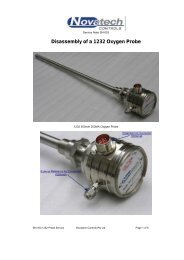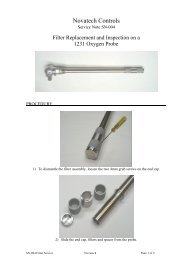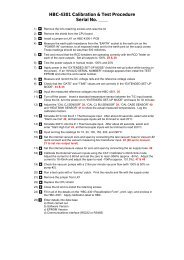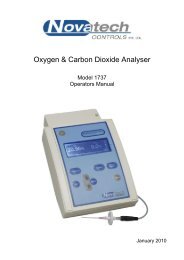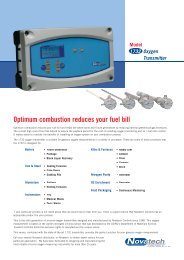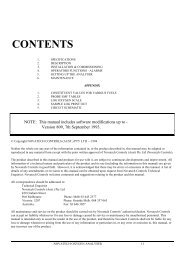1633 Combustion Controller Manual - Novatech Controls
1633 Combustion Controller Manual - Novatech Controls
1633 Combustion Controller Manual - Novatech Controls
You also want an ePaper? Increase the reach of your titles
YUMPU automatically turns print PDFs into web optimized ePapers that Google loves.
3.24 FILTER PURGINGPurging probe filters is controlled from the ‘PURGE’ button on the analyser when in ‘RUN’ mode. If ‘AUTOPURGE’ has been enabled in set-up 32, pressing the PURGE button will start the automatic cycle. Pressing any otherbutton will cancel the auto purge cycle. If AUTO PURGE was not enabled, the purge solenoid will only stay open foras long as the button is pressed. Gradually adjust the purge air supply regulator, increasing the pressure until sufficientflow is obtained to clear the filter. This is best checked with a dirty filter after a period of operation, by withdrawingthe probe from service and watching any build up on the filter being blown off at the set pressure. Normally 30 kPa (5psi) is adequate but the air pressure may be set as high as 100 kPa (15 psi).3.25 CALIBRATION GAS CHECKIf the installation has a filter purge facility, set this up first. Refer to the previous paragraph. Press the ‘CAL 1 or‘CAL 2’ button while in ‘SET UP’ mode to obtain a reasonable flow through the calibration check gas flow meter. Ifair is being used as a calibration check gas, use the air from the regulator for filter purge. Then, when setting up a gasfor calibration checking, set the pressure from the calibration gas cylinder so that it is the same as the pressure set onthe air regulator. Then the setting on the rotameter / flow regulator will be the same as that for the airflow. The flowrequired is 1 to 5 litres / minute (120 to 600 scfm) ) for a 1231 probe and up to 20 litres / minute (2400scfm) for anunheated probe.Air is not the best gas for calibration checking on a zirconia sensor. The output of a zirconia sensor with air on bothsides of the sensor is zero millivolts. It is better to choose a gas value which provides a reasonable output from thesensor and which is near to the process oxygen level. A cylinder with 2% oxygen in nitrogen is a commonly usedcalibration gas. The maximum pressure on the calibration check gas cylinder regulators is 100 kPa (15 psi).3.26 DUST IN THE FLUE GASFor unheated probes with no filter, entrained solids or dust in the flue gas does not present a problem unless the dust,when settled, is not porous. Allow the dust in the process to build up on the probe. It will form a porous layer slowingthe response time. To avoid mechanical abrasion of the electrode material in installations with unheated oxygenprobes, pack ‘SAFFIL’ or equivalent alumina based ceramic fibre in the sensing holes to protect the electrode. Do notuse silica based ceramic fibres such as ‘KAOWOOL’, which can attack the electrode at high temperatures. Once thedust has built up the response time of the probe will be slower.For heated probes the preferred method of mounting for dust-laden applications is facing vertically downwards with thefilter removed. Probes can also be mounted horizontally with no filter with some dusts. An occasional automatic backpurge is helpful in this case.Normally heated probes are supplied with filters for applications with particulates in the flue gas. The probe responsetime should be tested when the probe is first installed, and then regularly until it remains constant for a significantperiod. Filter purging should be set up on the time periods determined by these tests. To test the probe response time,use a stopwatch to obtain the time for a probe to achieve a 63 % change from one reading to another. If a probe filterblocks completely in a short period of time, then there is no option but to use the probe without the filter.3.27 STRATIFICATIONIf the analyser and probe have been fully tested and the oxygen readings in the flue gas are incorrect, gas stratificationmay be occurring. The phenomena cannot be anticipated for any particular installation. Generally, large flues haveoxygen differences of approximately one percent across the flue. Occasionally an oxygen error of several percent mayoccur in a flue of any size. Moving the probe to a new location normally solves this problem.August 200934 <strong>1633</strong> <strong>Combustion</strong> <strong>Controller</strong>



